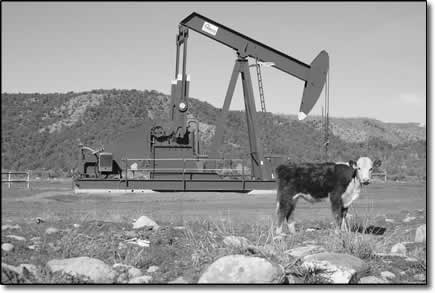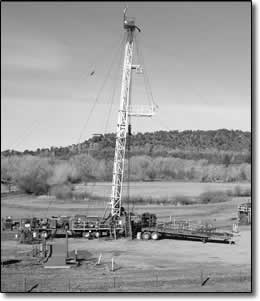|
Conservationists allege harm to drinking water

|
|
A pump sits idle south of Durango near County Road 214 early this week. Local environmentalists have concerns over a form of gas extraction called hydraulic fracturing, or frac'ing, which they charge is contaminating drinking water with toxins and is unregulated. The oil and gas industry counters that the practice is acompletely safe./Photo by Todd Newcomer.
|
by Will Sands
Jake Hottle has been dealing with tainted drinking water for several decades. Hottle was born
and raised on a farm located on the lower Animas River and remembers having clean well water as a child. However,
that changed when oil and gas drilling began in the Animas River corridor in the 1950s. Hottle says he clearly
recalls his mother struggling to drink water that carried a heavy, overpowering odor throughout the 1960s. He also
clearly remembers her premature passing at the age of 64 from cancer.
Hottle moved away, but he and his wife returned to the San Juan Basin in 1979 and immediately began to notice high
incidences of cancer in the old neighborhood. His personal experiences and those of his neighbors led him to form the
Cedar Hill Clean Water Coalition. Through investigations, the coalition steadily found poorly cemented wells and
open-pit dumping as well as methane gas in 40 percent of the water wells tested.
"After a long struggle, the industry finally went back in and properly cemented their wells, and they started lining
their pits," Hottle said. Based on these experiences, Hottle knows that local drilling is cleaner and more conscious
than it was 20 and 30 years ago.
"I think the industry is trying, and that's my observation," he said.
While proper cementing and pit lining are now mandated practices, Hottle and many others argue that the industry
needs to try still harder. There is widespread belief that a common drilling practice called hydraulic fracturing is
tainting aquifers and drinking water supplies with toxic chemicals. And while the industry maintains that the process
is harmless, conservationists counter that oil and gas companies are essentially policing themselves.
The Oil and Gas Accountability Project (OGAP) is a Durango-based organization with the mission of protecting
citizens, wildlife and livestock from the threats of unregulated oil and gas wastes. The OGAP has significant
concerns about hydraulic fracturing, or frac'ing (rhymes with packing).
The hard-to-reach
Hydraulic fracturing is a widely used drilling technique that allows access to hard-to-reach oil and gas deposits.
The deposits are reached by pumping liquids underground at high pressure. While the exact recipe of the liquids is
unknown, it is known to contain hazardous chemicals. Groups like the OGAP and San Juan Citizens' Alliance (SJCA)
suspect some of the chemicals remain in the ground and infiltrate water supplies. The issue has significance in the
San Juan Basin because nearly all of La Plata County's active 2,600 wells have been hydraulically fractured, and many
more than once.
"Almost every coalbed methane well here is frac'ed and a lot of them are frac'ed more than once," said Lisa Sumi,
research director with OGAP. "Sometimes the coal beds themselves are underground sources of drinking water. In some
cases, they're directly injecting those chemicals into drinking water."
Dan Randolph, oil and gas coordinator for the SJCA, added, "The amount of frac'ing that's going on here is more than
anywhere else in the country. There are thousands upon thousands of these jobs occurring with no studies of their
impacts."
Sumi further stated that while the industry claims that high-pressure brings the thousands of gallons of slurry back
to the surface, OGAP and others believe that is not the case.
"Studies show that a portion of those fluids remain underground," Sumi said. "Often, they use diesel instead of water
because they think it carries more of a 'profit' in terms of extraction. But diesel contains a lot of nasty things."
A lot of nasty things
Among those nasty things is benzene, a known carcinogen, but getting a grip on exactly what is going underground is
difficult, according to Randolph. "Basically, there are a whole lot of constituents that are injected and not
disclosed," he said. "Some of the known components are known to be harmful to human health. With frac'ing they are
injecting directly into drinking-water sources, and they're doing so with known harmful ingredients."
However, the EPA has done nothing to regulate it or discourage it, according to Sumi. "The EPA said there are
chemicals being injected at concentrations that can threaten people's health and yet they do nothing," she said.
Randolph added that hydraulic fracturing sits inside a regulatory loophole and is policed exclusively by the
companies themselves. "The status of regulation on hydraulic fracturing is completely contrary to every other process
of its kind," he said. "Underground exploration is a very regulated process until it comes to frac'ing, and then
there's no regulation whatsoever."

|
|
A drilling operation along Highway 160, near Bayfield, continues early this week. Hydraulic fracturing, where a slurry is injected into the well at high pressure in order to access deposits, is sure to be a part of the operation. Some of the slurry's contents are known carcinogens and conservationists fear that domestic wells are being contaminated./Photo by Todd Newcomer.
|
Randolph added that hydraulic fracturing sits inside a regulatory loophole and is policed exclusively by the
companies themselves. "The status of regulation on hydraulic fracturing is completely contrary to every other process
of its kind," he said. "Underground exploration is a very regulated process until it comes to frac'ing, and then
there's no regulation whatsoever."
The issue is particularly distressing given the cavalier energy policy of the Bush administration and heavy pressure
for local gas development. "The rate of energy development now is off the charts," Sumi said. "To even compare it
with the past is irrelevant."
Controlled and systematic
The oil and gas industry maintains that the practice is harmless. Locally, the La Plata County Energy Council
represents local oil and gas companies in an effort to promote safe and responsible natural gas development in La
Plata County. Christi Zeller, its executive director, countered that concerns about hydraulic fracturing are
unfounded.
"I've been on a frac'ing site," she said. "It's a very controlled and systematic way of fracturing a formation."
Zeller added that she's run her hand through hydraulic fracturing fluid, and that in her perception, it was
completely safe. Beyond that, she said that the council doesn't believe the relatively benign substance is traveling
or entering water wells.
"I have serious doubts that it's possible that this is getting into our water, and so does the EPA," she said. "Many
of the wells are fractured at over 2,000 feet of depth, and the formations are completely isolated from each other.
What the EPA says is what we believe. We're not damaging water wells."
Zeller concluded by saying that drilling companies have a strong record in La Plata County. "We've been drilling
natural gas wells for 50 to 60 years here," she said. "I would imagine that here in La Plata County, we've been doing
a good job."
Inside city limits
If there are some concerns about hydraulic fracturing when it is done right, there are serious concerns about when it
is done wrong. Shirley McNall, a resident of Aztec, N.M., and a SJCA member, witnessed the unthinkable in early
February near her home just east of the town and inside Aztec city limits.
"We saw a truck with a tank on it go behind a hill, where they dumped five to six barrels of frac fluid right on the
ground," McNall said. "The fluid ran into an arroyo. The arroyo runs through a subdivision, into a tributary listed
as vulnerable and endangered, and then into the Animas River."
The incident is currently being investigated by the New Mexico Oil Conservation Division and the Bureau of Land
Management. However, for McNall it is nothing new. She and her husband live close to nine different wells and this is
by no means the first suspicious incident.
In late January, she visited a well and found a newly painted, old production tank that was leaking gas out of two
rusted-out holes. The well is located approximately 80 feet from the Aztec Irrigation Ditch. At another nearby site,
the well head was submerged in deep water and gas was bubbling up in several places. In October of last year, she
noticed "foul-smelling, dark-colored fluid" running off a well pad, down a gully and puddling on a street less than
500 feet from subdivision homes. In September of last year, she visited a well near her home and found the ground wet
with gas. The list goes on to include things like split pit liners and noxious fumes.
"We've got nine wells surrounding our property, and of the nine, only one's not been a problem," McNall said.
The situation is distressing for McNall for several reasons. First, there is direct human impact from the sloppiness.
But those nine wells are also being monitored by neighboring residents. McNall said that the thousands of wells that
are not in back yards represent real concerns for her.
"All these episodes happened right here under our noses and
inside Aztec city limits," she said in closing. "Can you imagine
what's happening out in the middle of nowhere?"
Hydraulic
fracturing draws investigation
Whistle-blower triggers EPA internal review
|
The process of hydraulic
fracturing could come under serious scrutiny in the near future.
The Environmental Protection Agency’s inspector general
recently initiated an investigation after a whistle-blower
complained about the potential dangers of the process.
The EPA inspector general’s review was requested by
Democratic lawmakers after a Los Angeles Times report early
this winter. In the story, an EPA employee challenged an agency
study that found hydraulic fracturing posed “little
or no threat” to drinking water. The story reported
that several employees complained about the validity of the
study, among them Weston Wilson, an environmental engineer
in the EPA’s Denver office. Wilson prepared an 18-page
statement challenging both the study’s findings and
the way it was conducted. In the statement, he accused the
agency of failing to conduct field research and of relying
on a panel heavily biased toward the oil and gas industry.
The inspector general’s investigation comes at a curious
time. A Bush Administration energy bill is currently being
weighed and includes a provision that exempts hydraulic fracturing
from all federal regulation.
Locally, the Oil and Gas Accountability Project is applauding
the coming investigation. “We are planning on contacting
the inspector general and commenting,” said Lisa Sumi,
of the Durango-based Oil and Gas Accountability Project. “I
think it’s a great thing that the EPA has decided to
take a hard look at this.”
– Will Sands |
|